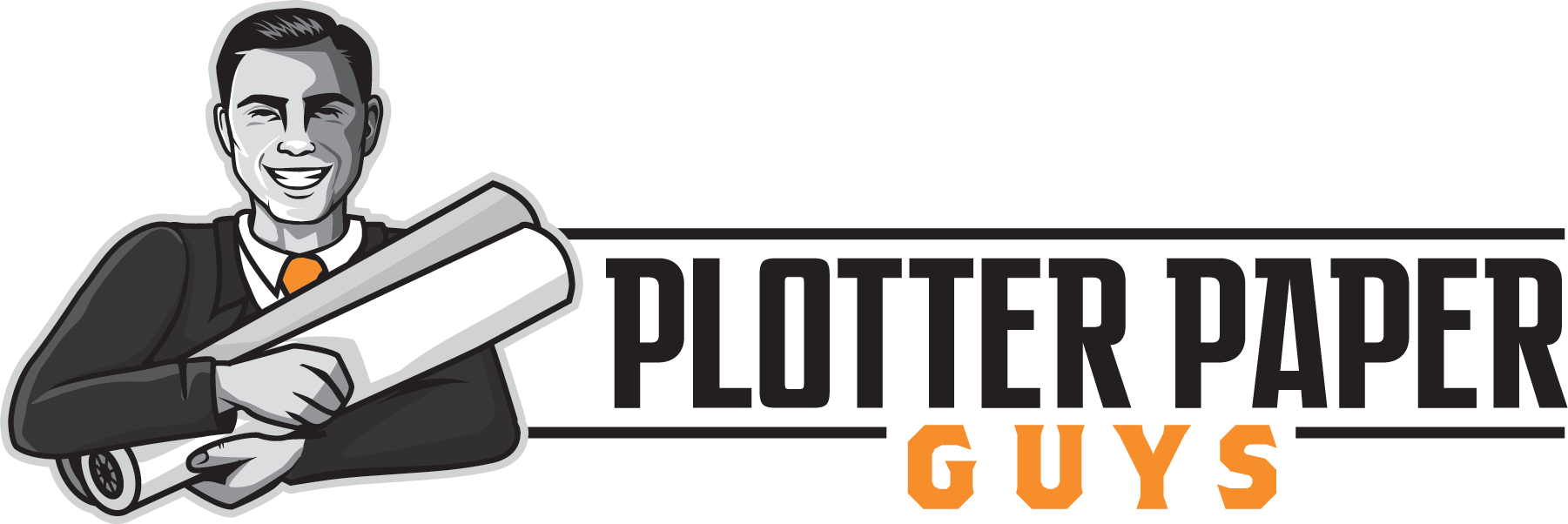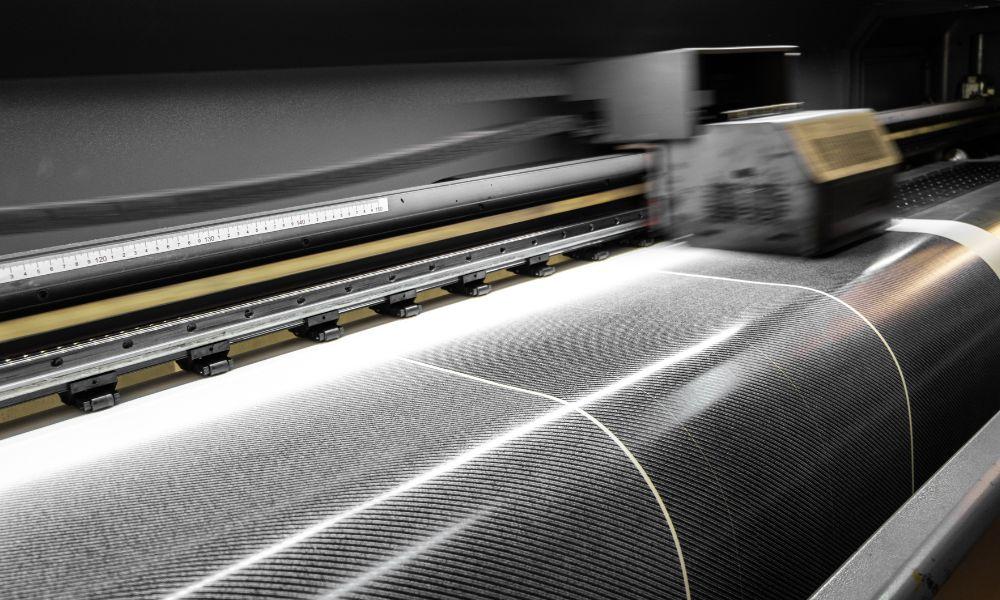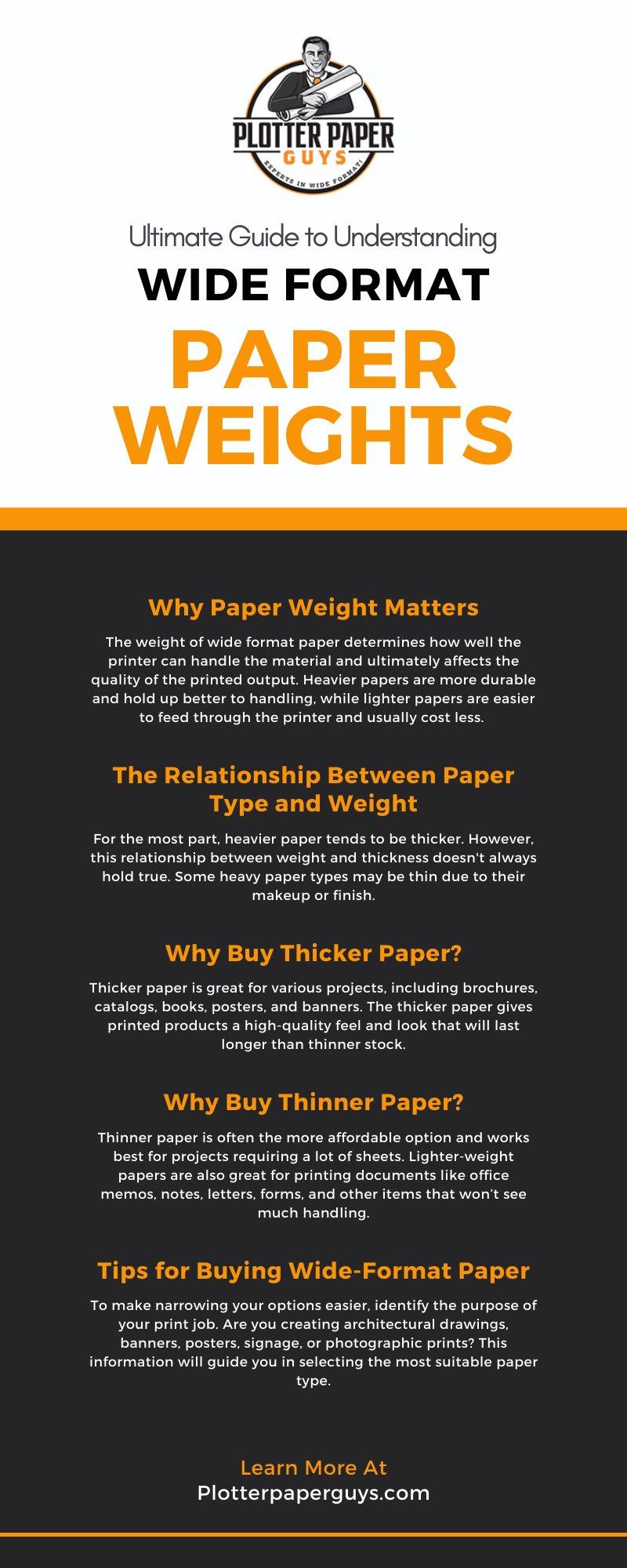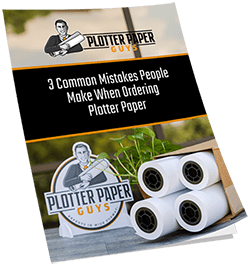If you’re a graphic designer, printing expert, or even an average consumer looking to learn more about wide-format paper weights, you’ve come to the right place. This article contains useful information and tips to teach you about paper weight so that you can shop confidently. Learn the terminology and get essential buying tips in our ultimate guide to understanding wide-format paper weights.
Why Paper Weight Matters
The weight of wide format paper determines how well the printer can handle the material and ultimately affects the quality of the printed output. Heavier papers are more durable and hold up better to handling, while lighter papers are easier to feed through the printer and usually cost less.
When selecting a type of paper for a print job, you need to know what the project is. For example, crafting brochures or pamphlets for a trade show requires thicker, heavier paper. On the other hand, when printing novels, we use thinner paper, which typically weighs less.
Common Weight Measurements
Most of the time, manufacturers display paper weight in pounds. However, the weight shown refers to the entire pack or roll, not single sheets. So, if you come across a 20 lb. roll of bonded paper, the whole roll is 20 lbs., not each sheet. Some also show pounds with a hashtag, which would be shown as 20# for 20 lbs.
Some manufacturers also measure weight with points, which is displayed as pt. or g/m2 on the product. Similar to weight, a higher point value signifies a thicker paper. Points or “mil” is standard in the US, while other parts of the world use grams per meter squared (g/m2).
Most newspapers are around 35 g/m2, while standard copy paper is around 75g/m2. It is vital to understand the difference in weight, whether the manufacturer displays it in g/m2, #, or mils. Using the wrong option can negatively impact your project or damage the printer.
The Relationship Between Paper Type and Weight
Next in our guide to understanding wide-format paper weights, let’s get into how paper-type impacts weight. For the most part, heavier paper tends to be thicker. For example, if you held a piece of copy paper in one hand and cardstock in the other, the latter option would feel thicker and heavier. However, this relationship between weight and thickness doesn’t always hold true. Some heavy paper types may be thin due to their makeup or finish.
If the manufacturers label a paper as “heavyweight,” or you see this in the product description, it’s most likely a thicker paper. When you doubt the weight, always check with the manufacturer or supplier for more information before purchasing. Knowing the paper’s specific weight can help you ensure the ideal turnout for your prints.
Coated and Uncoated Paper
Both coated and uncoated paper comes in a wide range of weights because each option best serves various purposes. For instance, you may use 20 lbs. xerographic bond paper for crafting architectural drawings printed from a Xerox, KIP, or OCE printer. However, this would not be ideal for a graphic artist printing marketing posters. That paper would be too thin and wouldn’t have the glossy coating often used for these signs.
Thick vs. Thin Paper
So, which option is best, thick or thin paper? There is no single answer to this question, as it depends on your project and the printer you’ll use. Using extra thin paper for a marketing poster is anything but ideal. The highly-pigmented colors used to print this type of project could bleed and leave the artwork looking more like a mess than anything. Despite this, there are situations where lightweight stock is the best option, such as when printing a memo.
Why Buy Thicker Paper?
Thicker paper is great for various projects, including brochures, catalogs, books, posters, and banners. The thicker paper gives printed products a high-quality feel and look that will last longer than thinner stock. If you need to print items that will see frequent handling, such as menus or postcards for mailings, thicker paper is the perfect option.
Keep in mind that thicker doesn’t always mean better. Your printer may not have the ability to handle extra-thick stock. Trying to force it could jam and damage the machine.
Why Buy Thinner Paper?
Thinner paper is often the more affordable option and works best for projects requiring a lot of sheets. Lighter-weight papers are also great for printing documents like office memos, notes, letters, forms, and other items that won’t see much handling.
Tips for Buying Wide-Format Paper
Heavier papers are more expensive, but they offer superior print quality, better resistance against handling, and a heavier feel that gives any project a professional look and feel. To make narrowing your options easier, identifythe purpose of your print job. Are you creating architectural drawings, banners, posters, signage, or photographic prints? This information will guide you in selecting the most suitable paper type.
After knowing the paper’s purpose, consider the weight options and how they relate to your project. Heavier weights are more durable and provide a higher-quality finish than lighter weights. Of course, if you need to print a first draft of a building design, you don’t need the thickest paper.
Understand Your Printer Requirement
Review the printer manual to see what the manufacturer recommends as a weight minimum and maximum. Using the wrong option could jam your printer. Take note of what’s recommended and follow this guide as you shop to ensure you make the best purchase.
Shop for Quality
When shopping for wide-format paper, it’s essential to buy high-quality stock to ensure the best printing results. High-quality papers are usually acid-free, lignin-free, and of archival quality. This means they won’t yellow or fade over time, as some low-cost options may do.
As you evaluate paper weight options, evaluate quality as well, then compare both with the product’s price. This gives you a better idea of the paper’s value, which is the most important consideration.
Buy Here
Buy from the Plotter Paper Guys as you shop for top-quality paper for your next project. Options such as our 24 lb. bond paper work in various aqueous inkjet printers, including HP, Canon, and Epson. Please contact us if you have any questions about our paper options or which weight you should purchase.





